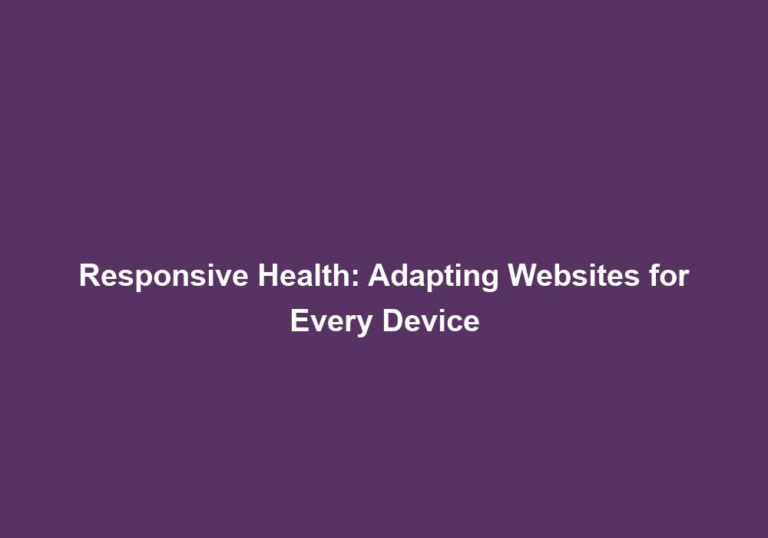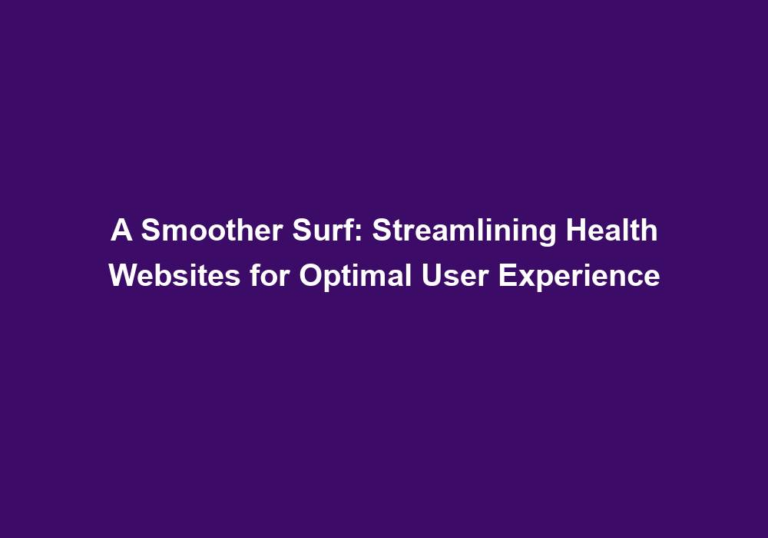Staying Hooked: Strategies for Sustaining Engagement in Health Apps
In today’s digital era, health apps have gained immense popularity as a tool for promoting healthy lifestyles and tracking personal wellness goals. However, one of the biggest challenges faced by developers and users alike is sustaining long-term engagement with these apps. Many individuals start off with great enthusiasm but gradually lose interest or motivation over time. To address this issue, it’s crucial to implement effective strategies that encourage users to stay hooked and continue using health apps regularly. In this article, we will explore some proven strategies to enhance engagement in health apps.
1. Personalization is Key
To keep users engaged, health apps must cater to their unique needs and preferences. Personalization plays a pivotal role in creating a sense of ownership and customization. By allowing users to set personalized goals, track progress, and receive tailored recommendations, health apps can provide a more individualized experience.
Benefits of Personalization:
- Users feel a sense of ownership and control over their health journey.
- Personalized goals ensure that users are working towards objectives that are meaningful and relevant to their specific needs.
- Tailored recommendations provide users with relevant and actionable insights, increasing the likelihood of adherence to healthy behaviors.
Methods for Personalization:
- Allow users to customize challenges, reminders, and notifications according to their preferences.
- Provide options for users to input their personal data, such as age, gender, and medical history, to receive more accurate recommendations.
- Offer different modes or levels of difficulty to cater to users with varying fitness levels and abilities.
2. Gamify the Experience
Incorporating gamification elements can significantly enhance engagement in health apps. By introducing challenges, achievements, and rewards, developers can tap into users’ competitive nature and innate desire for recognition. Leaderboards, badges, and virtual rewards not only add a fun element to the app but also create a sense of accomplishment and motivation.
Benefits of Gamification:
- Increases user motivation by turning health-related activities into a game-like experience.
- Fosters a sense of achievement and progress, encouraging users to continue using the app.
- Enhances social interaction and friendly competition among users, further boosting engagement.
Methods for Gamification:
- Create challenges or missions that users can complete to earn rewards or unlock new features.
- Implement a point-based system where users can accumulate points by achieving specific milestones or engaging in healthy behaviors.
- Allow users to compete with friends or join communities to compare progress and achievements.
3. Provide Regular Feedback and Progress Tracking
To sustain engagement, health apps must provide continuous feedback and progress tracking. Users should be able to see tangible results, such as improvements in fitness levels, weight loss, or better sleep patterns. Graphs, charts, and visual representations of progress can be highly motivating, allowing users to monitor their achievements and stay on track with their goals. Regular reminders and notifications can also serve as gentle prompts to keep users engaged and accountable.
Benefits of Feedback and Progress Tracking:
- Reinforces a sense of accomplishment and progress, motivating users to continue their healthy habits.
- Provides users with insights into their performance, allowing them to make informed decisions and adjustments.
- Increases accountability and adherence to goals through reminders and notifications.
Methods for Feedback and Progress Tracking:
- Display progress through visually appealing graphs and charts that show improvements over time.
- Send regular notifications reminding users to log their activities or check their progress.
- Provide personalized feedback based on users’ performance, offering suggestions for improvement.
4. Leverage Social Support
The power of social support should not be underestimated when it comes to sustaining engagement in health apps. Integrating social features, such as the ability to connect with friends, join communities, or share accomplishments on social media, can foster a sense of belonging and accountability. Peer support and encouragement can play a significant role in motivating users to stay committed to their health goals.
Benefits of Social Support:
- Creates a sense of community and belonging, reducing feelings of isolation and increasing motivation.
- Provides opportunities for users to share experiences, challenges, and success stories, fostering a supportive environment.
- Encourages healthy competition and collaboration among users, further boosting engagement.
Methods for Leveraging Social Support:
- Allow users to connect with friends or invite them to join challenges or activities together.
- Create communities or forums within the app where users can interact, share tips, and support each other.
- Enable users to share their achievements or progress on social media platforms, promoting a sense of pride and accountability.
5. Offer Incentives and Challenges
Motivating users to stay engaged can be achieved through the introduction of incentives and challenges within the health app. For example, users could earn points or unlock exclusive content by consistently using the app or achieving specific milestones. Challenges, such as 30-day fitness programs or healthy eating plans, can also create a sense of excitement and commitment. By continuously offering new challenges and incentives, health apps can keep users engaged and invested in their wellness journey.
Benefits of Incentives and Challenges:
- Provides tangible rewards and incentives for users to stay engaged and committed.
- Adds an element of excitement and novelty, preventing monotony and boredom.
- Encourages users to push their limits and strive for continuous improvement.
Methods for Offering Incentives and Challenges:
- Implement a rewards system where users can earn points, badges, or virtual rewards for completing tasks or achieving goals.
- Create time-bound challenges or programs that users can participate in, offering a sense of structure and achievement.
- Collaborate with partners or sponsors to offer exclusive discounts or perks to users who reach specific milestones.
6. Continuous Improvement and Innovation
To prevent user fatigue and maintain engagement, health apps need to continuously evolve and improve. Regular updates, bug fixes, and the introduction of new features based on user feedback can keep the app fresh and appealing. Developers should actively seek user input and stay abreast of emerging trends and technologies to ensure their app remains competitive and meets evolving user expectations.
Benefits of Continuous Improvement and Innovation:
- Demonstrates a commitment to delivering the best user experience and addressing user needs.
- Keeps the app relevant and up-to-date with the latest advancements in technology and health practices.
- Encourages user loyalty and trust by showing responsiveness to feedback and suggestions.
Methods for Continuous Improvement and Innovation:
- Regularly release updates that address bug fixes, performance enhancements, and new features.
- Conduct user surveys or feedback sessions to gather insights and identify areas for improvement.
- Stay informed about industry trends, research, and user preferences to anticipate future needs and adapt accordingly.
7. Simplify User Interface and Navigation
A user-friendly and intuitive interface is vital for sustaining engagement in health apps. Complex or cluttered designs can deter users and make the app difficult to navigate. It’s crucial to streamline the user experience, ensuring that key features are easily accessible and the app’s functionality is self-explanatory. Clear instructions, intuitive icons, and a visually pleasing design can significantly enhance user satisfaction and retention.
Benefits of Simplified User Interface and Navigation:
- Reduces user frustration and confusion, increasing the likelihood of app adoption and continued usage.
- Enhances user satisfaction by providing a seamless and intuitive experience.
- Improves accessibility for users with varying levels of digital literacy or technological proficiency.
Methods for Simplifying User Interface and Navigation:
- Use a clean and minimalist design with clear typography and appropriate spacing.
- Optimize the app’s layout to prioritize essential features and minimize clutter.
- Incorporate intuitive icons and labels to guide users and make the app’s functionality self-explanatory.
8. Provide Educational Content and Resources
Health apps can go beyond simple tracking and offer valuable educational content and resources. By providing informative articles, videos, or podcasts related to nutrition, fitness, mental health, or general wellness, apps can become a comprehensive source of knowledge and support for users. When users perceive the app as a valuable educational tool, they are more likely to stay engaged and view it as an essential part of their overall health journey.
Benefits of Providing Educational Content and Resources:
- Empowers users with knowledge and insights to make informed decisions about their health.
- Establishes the app as a trusted and reliable source of information, fostering user loyalty.
- Enhances user engagement by providing additional value beyond basic tracking and goal-setting.
Methods for Providing Educational Content and Resources:
- Curate a library of articles, videos, or podcasts covering various health topics of interest.
- Collaborate with experts or influencers to create exclusive educational content for app users.
- Send regular newsletters or push notifications with informative tips, advice, or updates on the latest research.
Conclusion
Sustaining engagement in health apps is crucial for users to derive long-term benefits and achieve their health goals. By implementing a combination of personalization, gamification, progress tracking, social support, incentives, continuous improvement, intuitive design, and educational content, health apps can create an immersive and motivating experience. It is through the collective application of these strategies that developers can ensure users stay hooked, fostering healthier habits and ultimately improving overall well-being.







